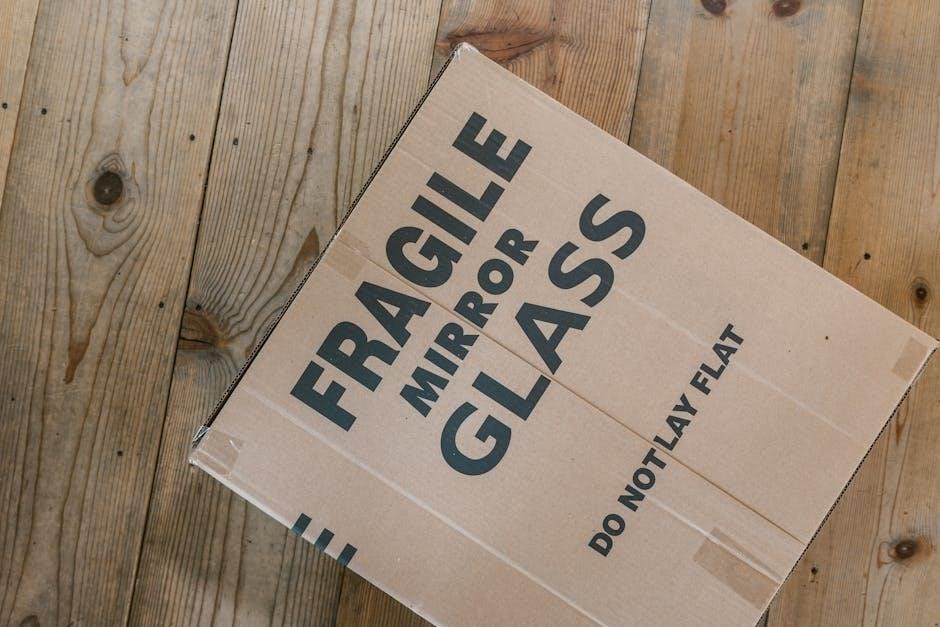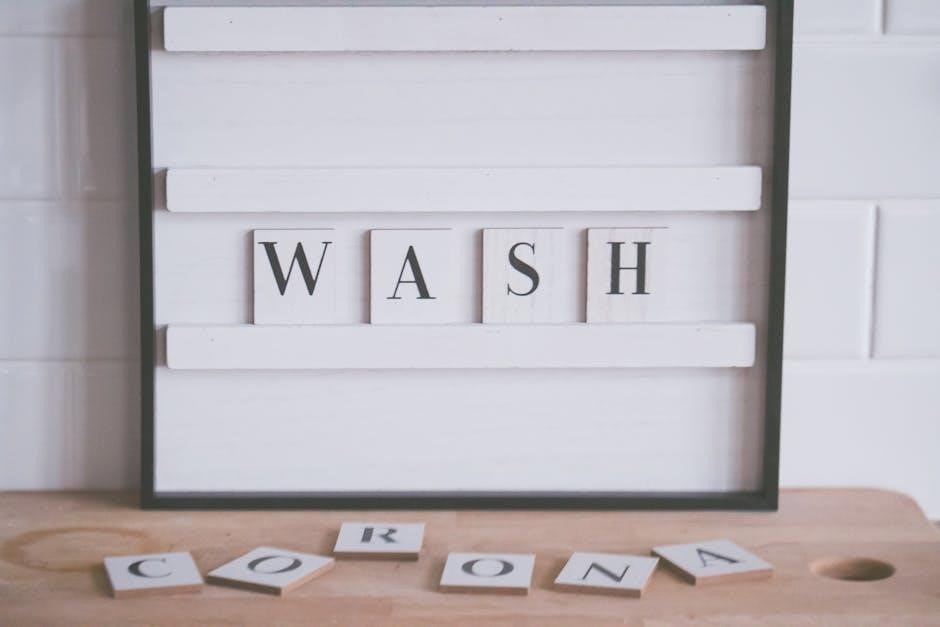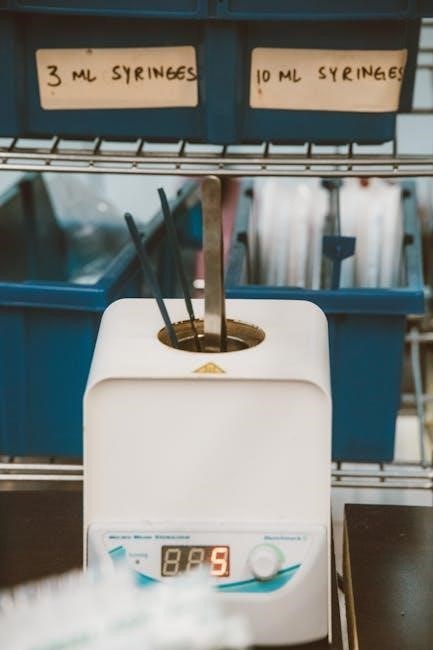The Philips Avent Sterilizer offers efficient steam sterilization for baby bottles and accessories, ensuring 99․9% germ elimination․ Its design combines ease of use with effectiveness, providing peace of mind for new parents․
What is the Avent Sterilizer?
The Philips Avent Sterilizer is a high-quality, efficient appliance designed to sterilize baby bottles, nipples, and other feeding accessories․ It uses natural steam to eliminate 99․9% of harmful bacteria and germs, ensuring a safe and hygienic environment for your baby’s feeding essentials․ Available in both microwave and electric models, the Avent Sterilizer is versatile and easy to use, making it a practical solution for busy parents․ Its compact design and compatibility with various Philips Avent baby products make it a popular choice for maintaining cleanliness and hygiene․ The sterilizer is also designed to keep items sterile for up to 24 hours if left sealed, providing added convenience for parents․ Whether you’re sterilizing bottles, pacifiers, or other baby items, the Avent Sterilizer offers a reliable and effective method for keeping your baby’s belongings clean and safe․
Benefits of Using the Avent Sterilizer
The Philips Avent Sterilizer provides numerous benefits for parents seeking a reliable and efficient way to maintain hygiene for their baby’s feeding essentials․ Its natural steam sterilization process effectively eliminates 99․9% of harmful bacteria and germs, ensuring a safe environment for baby bottles, nipples, and accessories․ The sterilizer is easy to use, with clear instructions and a straightforward process that fits seamlessly into a busy parent’s routine․ Additionally, the sterilizer maintains sterility for up to 24 hours if left sealed, offering convenience for parents who want to prepare items in advance․ Its compatibility with various Philips Avent products makes it a versatile and practical choice for families․ Overall, the Avent Sterilizer combines efficiency, safety, and ease of use, making it an essential tool for maintaining cleanliness and hygiene in baby care․

Safety Precautions
The Philips Avent Sterilizer requires careful handling to avoid burns․ Always ensure the microwave is clean and dry before use․ Never immerse electrical components in water to prevent shocks․

General Safety Guidelines
Using the Philips Avent Sterilizer safely is essential to ensure effective sterilization and prevent accidents․ Always read the user manual thoroughly before first use․ Keep the sterilizer out of reach of children and avoid touching hot surfaces during operation․ Ensure the microwave is clean and dry to prevent splatter or damage․ Never immerse the electrical cord or base in water, as this could cause electrical shock․ Avoid sterilizing items filled with liquid, such as teething toys with cooling fluid, as this may lead to improper sterilization or damage․ Regularly inspect the sterilizer and accessories for wear or damage, and replace them if necessary․ For optimal performance, descale the sterilizer periodically to remove mineral buildup․ Follow recommended water levels and guidelines to maintain efficiency and safety․
Important Safety Notes Before Use
Before using the Philips Avent Sterilizer, ensure all components are clean and free from damage․ Inspect the sterilizer and accessories regularly for signs of wear or weakness․ Avoid exposing feeding teats to direct sunlight or heat, as this may weaken the material․ Never leave a feeding teat in disinfectant solution longer than recommended, as it may degrade the quality․ Do not place feeding teats or the sterilizer in a heated oven, as this could cause damage or safety hazards․ Ensure the microwave is clean and dry before sterilizing to prevent splatter or damage․ Always follow the recommended water levels and guidelines provided in the manual to avoid improper sterilization․ For optimal safety, register your product and refer to the user manual for specific instructions and precautions․ Proper pre-use checks ensure effective sterilization and longevity of the device․

Preparation Steps
Preparation involves cleaning the sterilizer before first use, inspecting all parts for damage, and ensuring all items are compatible with the sterilization process․
Cleaning Before First Use
Before using your Philips Avent Sterilizer for the first time, thoroughly clean all components with mild soap and warm water using a soft sponge or cloth․ Avoid using abrasive materials or harsh chemicals, as they may damage the surfaces․ Rinse all parts meticulously to remove any soap residue, ensuring no streaks or particles remain․ For stubborn stains or odors, soak the parts in warm, soapy water for about 15 minutes before scrubbing gently․ After cleaning, dry the components with a clean, dry cloth to prevent water spots․ Some users also recommend sterilizing the parts in boiling water or running a sterilization cycle before initial use for added safety․ This step ensures the sterilizer is hygienic and ready for effective use․ Always refer to the user manual for specific cleaning recommendations tailored to your model․
Inspecting the Sterilizer and Accessories
Before each use, inspect the Philips Avent Sterilizer and its accessories for any signs of damage or wear․ Check the lid, seals, and steam holes for blockages or cracks, as these can affect sterilization efficiency․ Ensure all parts are free from visible mold or residue, which may indicate improper cleaning or drying․ Examine the power cord and plug for frays or damage to avoid electrical hazards․ For accessories like bottles and nipples, stretch the teats to check for tears or thinning, and discard any damaged items․ Regular inspection helps maintain the sterilizer’s performance and ensures safe, effective sterilization․ If any damage is detected, discontinue use and refer to the user manual for guidance on replacements or repairs․ Proper inspection is key to prolonging the lifespan of your Philips Avent Sterilizer and keeping your baby’s items hygienic․
Understanding Compatible Items for Sterilization
The Philips Avent Sterilizer is designed to sterilize a variety of baby essentials, including bottles, nipples, pacifiers, and breast pump accessories․ Ensure all items are compatible with steam sterilization and free from materials that may degrade under high heat, such as certain plastics or metals․ Avoid sterilizing items with electronic components, wooden parts, or those filled with liquid, like teething toys with cooling gel․ Always check the manufacturer’s guidelines for specific items to confirm their suitability for steam sterilization․ Using incompatible items may result in damage or compromise the sterilization process․ For optimal results, only place items that are specifically designed for steam sterilization in the Philips Avent Sterilizer․ This ensures effective germ elimination and maintains the longevity of both the sterilizer and the accessories․ Proper selection of items guarantees a safe and hygienic process for your baby’s belongings․

Sterilization Process
The Philips Avent Sterilizer uses steam to kill 99․9% of germs in just minutes․ Simply add water, load items, and select the cycle․ The process is quick, efficient, and ensures items remain sterile for up to 24 hours when sealed․
Step-by-Step Guide for Microwave Sterilization
To use the Philips Avent Microwave Sterilizer, start by adding 130ml of distilled water to the water reservoir․ Place the sterilizer base on a flat surface and ensure the water level is correct․ Next, load the bottles, nipples, and accessories into the sterilizer, facing downward to allow steam to circulate evenly․ Secure the lid tightly and place the sterilizer in the microwave․ Set the microwave power according to the recommended wattage (usually 800-1000W) and cook for 2-3 minutes․ After the cycle, let the sterilizer stand for 3 minutes before carefully removing it with oven mitts․ Allow the items to cool slightly before storing․ This method ensures 99․9% of germs are eliminated, providing a safe and hygienic way to sterilize baby essentials․
Step-by-Step Guide for Electric Sterilization

For electric sterilization, begin by filling the water reservoir with 130ml of distilled water․ Place the Philips Avent Electric Sterilizer on a stable surface and ensure the base is properly aligned․ Load the bottles, nipples, and accessories into the sterilizer, positioning them facing downward for optimal steam circulation․ Secure the lid firmly to lock it in place; Plug in the device and select the appropriate sterilization cycle using the control panel․ The sterilizer will automatically generate steam, typically taking 6-8 minutes to complete the cycle․ Once the process is done, allow the sterilizer to cool briefly before opening․ The items will remain sterile for up to 24 hours if the lid stays closed․ This method ensures efficient and consistent sterilization, making it a convenient option for daily use․
Recommended Water Levels and Guidelines
For optimal performance, the Philips Avent Sterilizer requires precise water levels․ Fill the water reservoir with exactly 130ml of distilled water to ensure proper steam generation without overflow․ Using distilled water prevents mineral buildup and maintains the sterilizer’s efficiency․ Avoid exceeding the recommended water level, as this can lead to poor steam distribution and ineffective sterilization․ If using an electric model, ensure the reservoir is filled before each cycle․ For microwave sterilization, the water level should align with the marked guidelines on the sterilizer base․ After each use, pour out any remaining water once the sterilizer has cooled to prevent bacterial growth․ Adhering to these guidelines ensures consistent sterilization results and prolongs the lifespan of the device․ Regularly cleaning and descaling the sterilizer will also help maintain its performance and hygiene standards․ Always refer to the user manual for specific water level recommendations tailored to your Avent Sterilizer model․

Post-Sterilization Care
After sterilization, store items in a clean, dry place․ Allow the sterilizer to cool before handling․ Ensure it remains dry to prevent bacterial growth and maintain hygiene standards․

Storage of Sterilized Items
After sterilization, store items in a clean, dry environment to maintain their sterility․ If using the Avent Sterilizer, items can remain sterile for up to 24 hours if the lid stays closed․ For optimal results, place sterilized bottles and accessories in a sealed container or ziplock bag․ Avoid storing items in direct sunlight or humid areas, as this may compromise their sterility․ Ensure all storage surfaces are clean and dry before placing items on them․ For items not used immediately, label and date the storage container for easy tracking․ Always check for visible signs of damage or wear before reusing stored items․ Proper storage helps maintain hygiene and ensures your baby’s feeding essentials remain safe and clean․
Maintenance and Cleaning of the Sterilizer
Regular maintenance and cleaning of the Avent Sterilizer are essential to ensure optimal performance and hygiene․ After each use, wipe the interior and exterior with a soft, clean cloth to remove any moisture or residue․ Avoid using abrasive cleaners or scrubbers, as they may damage the surfaces․ For tougher stains or mineral buildup, mix equal parts water and white vinegar in the sterilizer and run a sterilization cycle․ Rinse thoroughly afterward to prevent any lingering vinegar taste․ Check and clean the steam vents and water reservoir regularly to ensure proper steam flow and prevent blockages․ Always dry the sterilizer thoroughly after cleaning to prevent mold or mildew growth․ Refer to the user manual for specific cleaning instructions tailored to your model․ Proper maintenance extends the lifespan of the sterilizer and ensures consistent sterilization results․
Descaling and Regular Maintenance Tips
Descaling is crucial for maintaining your Avent Sterilizer, especially in areas with hard water, as mineral deposits can build up over time․ Regularly check for limescale accumulation in the water reservoir, steam vents, and other components․ Mix a descaling solution, such as equal parts water and white vinegar, and run a sterilization cycle to help dissolve mineral deposits․ For tougher buildup, let the solution sit for 30 minutes before rinsing thoroughly․ After descaling, ensure all parts are rinsed to remove any residue․ Regularly cleaning the sterilizer and checking for blockages in steam vents will prevent performance issues․ Replace worn-out parts promptly and store the sterilizer in a dry place when not in use․ Proper descaling and maintenance ensure efficient operation and extend the lifespan of your Avent Sterilizer, keeping it in optimal condition for sterilizing baby essentials․

Troubleshooting Common Issues
Common issues with the Avent Sterilizer include improper locking, steam blockages, or mineral buildup․ Regular descaling and ensuring the lid is securely closed can resolve many problems․ Always refer to the user manual for specific solutions to maintain optimal performance․
Resolving Common Errors or Malfunctions
If the Avent Sterilizer shows an error or malfunctions, start by checking the power connection and ensuring the lid is properly locked․ Descale the unit regularly to prevent mineral buildup, which can disrupt steam flow․ Clean the steam holes and vents with a soft brush to remove any blockages․ If the sterilizer doesn’t turn on, verify that it’s correctly plugged in and the outlet is functioning․ For persistent issues, reset the device by unplugging it for 30 minutes․ Always refer to the user manual for specific troubleshooting steps․ If problems persist, contact Philips Avent customer support for assistance․ Regular maintenance can prevent many common errors and ensure effective sterilization․ Keep the sterilizer clean and dry after each use to maintain its performance and longevity․ Addressing issues promptly helps ensure your baby’s items remain safe and hygienic․
Addressing Odors or Residue in the Sterilizer
If your Avent Sterilizer develops an odor or residue, start by cleaning it thoroughly with mild soap and warm water․ Rinse all parts and dry them completely to prevent moisture buildup․ For persistent odors, mix equal parts water and white vinegar in the sterilizer and run a sterilization cycle․ This natural solution helps neutralize smells and remove residue․ Regularly descaling the sterilizer can also prevent mineral deposits, which may contribute to odors․ After each use, ensure the sterilizer is dry, as leftover water can lead to mold or mildew․ If the sterilizer is not in use for an extended period, store it with the lid open to allow airflow․ Always check for blockages in steam holes or vents, as residue can accumulate there․ By maintaining proper hygiene and addressing odors promptly, you can keep your Avent Sterilizer in excellent condition and ensure effective sterilization․ Regular cleaning and maintenance are key to preventing future issues․

Additional Tips for Effective Use
Optimize sterilization cycles by pre-cleaning items and ensuring compatibility․ Regularly check for blockages in steam holes and vents to maintain efficiency․ This ensures consistent and effective sterilization results every time․
Optimizing Sterilization Cycles for Efficiency
To optimize the Avent Sterilizer’s efficiency, ensure all items are properly cleaned before sterilization․ Remove any residual milk or debris, as this can hinder steam circulation․ Always load bottles and accessories in an upright position to allow steam to reach all areas evenly․ For electric sterilization, use the recommended water level and distilled water to prevent mineral buildup․ Regularly descale the unit to maintain performance and extend its lifespan․ Additionally, avoid overcrowding the sterilizer, as this can reduce effectiveness․ By following these steps, you ensure a thorough sterilization process while maintaining the longevity of your device․ Proper maintenance and adherence to guidelines are key to achieving optimal results consistently․
Using the Sterilizer for Other Baby Accessories
The Avent Sterilizer is versatile and can be used to sterilize various baby accessories beyond bottles․ Pacifiers, nipples, breast shields, and even some toys can be safely sterilized using this device․ Ensure compatibility by checking the manufacturer’s guidelines or the user manual․ Place items in the sterilizer basket, making sure they are exposed to steam evenly․ Avoid overcrowding to allow proper steam circulation․ Note that certain materials, such as electronic components or certain plastics, may not be suitable for steam sterilization․ Always clean accessories before sterilization and follow the recommended cycle times․ This feature makes the Avent Sterilizer a convenient solution for maintaining hygiene across multiple baby essentials․ Regular use helps prevent the growth of harmful bacteria, ensuring a safe environment for your baby․
Philips Avent Sterilizer offers efficient sterilization, ensuring your baby’s safety․ For further assistance, visit Philips Avent support or consult the user manual․
Final Thoughts on Using the Avent Sterilizer
The Philips Avent Sterilizer is a reliable and efficient solution for sterilizing baby essentials, ensuring 99․9% of germs are eliminated․ Its user-friendly design and versatility make it a practical choice for busy parents․ By following the provided instructions and maintaining regular cleaning and descaling, you can extend the lifespan of the sterilizer and ensure optimal performance․ Always refer to the user manual for specific guidelines, and for additional support, visit the Philips Avent website or contact their customer service․ This sterilizer not only offers peace of mind but also fits seamlessly into your daily routine, helping you keep your baby’s feeding accessories clean and safe․
Where to Find Additional Support and Manuals
For additional support and detailed instructions, visit the official Philips Avent website․ There, you can find user manuals, FAQs, and troubleshooting guides specific to your sterilizer model․ Use the model number (e․g․, SCF284 or SCF293) to locate precise documentation․ The website also offers downloadable PDF manuals and helpful tips for maintenance and usage․ Additionally, Philips Avent provides customer service support for any queries or issues․ For further assistance, explore support articles, instructional videos, and community forums where users share their experiences․ Always ensure to refer to authorized sources for accurate and up-to-date information․ Regularly check for updates or recalls to keep your sterilizer functioning optimally․ By utilizing these resources, you can maximize the efficiency and longevity of your Avent Sterilizer․
